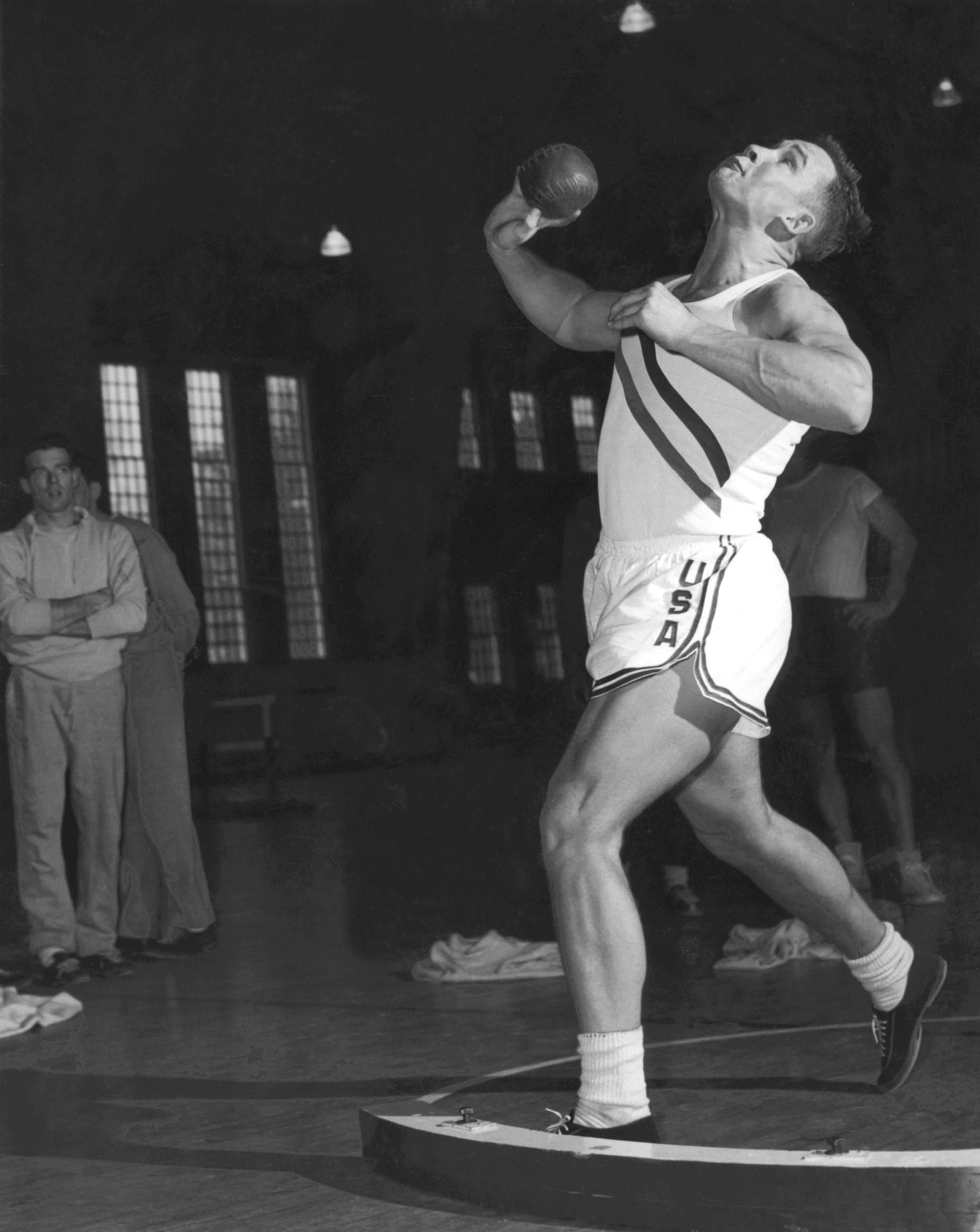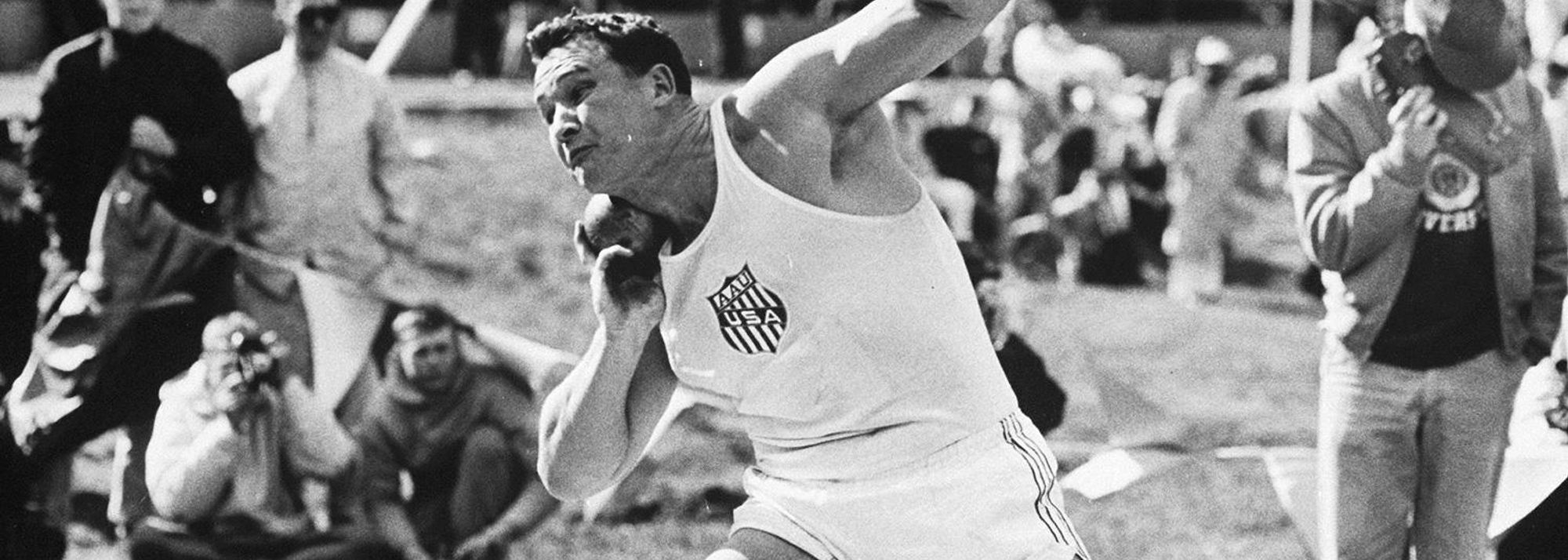Parry O'Brien (© Getty Images)
The Fresno State University Band had just struck up The Star Spangled Banner when Parry O’Brien prepared to take his fourth round throw in the shot competition at the West Coast Relays meeting at Ratcliffe Stadium, Fresno, on the evening of 9 May 1953.
Such were the Californian’s mental powers, he was able to channel the strains of the US national anthem into a mighty effort that took him to the first 18-metre put in history: 18.00m precisely, 59ft 3/4in in imperial terms.
In the process, the 21-year-old sophomore from the University of Southern California entered the world record books for the first time, eclipsing the three-year-old distance of 17.95m set by compatriot Jim Fuchs at Eskilstuna in Sweden in 1950.
O’Brien also claimed the scalp of one of the all-time greats of US track and field. Bob Mathias finished sixth with 15.49m. A resident of Fresno, the 32-year-old had created Olympic history in Helsinki the previous year, becoming the first man to retain the decathlon title. He was also a three-time world record-breaker in the decathlon.
O’Brien was already an Olympic champion himself, having claimed gold in the shot as a rookie 20-year-old US track and field teammate of Mathias in the Finnish capital in 1952. He proceeded to became a two-time Olympic champion in his event – and a serial world record-breaker.
That 18.00m effort in Fresno was to be the first of 17 global shot marks in six years achieved by O’Brien. Ten of them were official world records, six unratified, and one a record-equalling mark. The last was a 19.30m put in Albuquerque in 1959.
Thompson untaps ‘The Podge’s’ potential
William Parry O’Brien was the colossus of the shot put. The first man to breach the 60ft barrier, he transformed his event with the revolutionary technique that bore his name – the O’Brien Glide – and with the holistic mental and physical approach he developed towards preparation and competition.
He competed in four successive Olympic Games, claiming gold in 1952 and 1956, silver in 1960, and finishing fourth in 1964. Between July 1952 and June 1956, he was unbeaten in 116 competitions – a record winning streak until the majestic Edwin Moses gracefully glided to 122 successive victories in the 400m hurdles from 1977 to 1987.

Parry O’Brien in 1955 (© AFP / Getty Images)
Born in Santa Monica in 1932, O’Brien became a US football prodigy in his youthful days in the South California coastal resort. His father had been a professional minor leagues baseball player and tried to steer him towards that sport but Parry found his build (6ft 3in, 17st) better suited to football.
Nicknamed “The Podge,” he led Santa Monica High School to the state championship in 1948, earning a football scholarship to the University of Southern California. After painfully tearing the muscles in his mid-section when kicked in the stomach during a practice session in his freshman year at USC, however, his football fervour started to wane.
O’Brien had already been introduced to the shot and discus as part of regulation spring-time athletics training and, while working out with the college track and field team the following year, he was introduced to Wilbur Thompson, the former USC student who won shot put gold at the 1948 Olympics in London.
Spotting untapped potential, Thompson prompted O’Brien to change his scholarship from football to track and field.
Eureka!
An international class shot putting talent soon emerged, harnessed by a ruthless competitive instinct and a forensically analytical mind.
After losing at the 1951 Fresno Relays (to Otis Chandler, who later became publisher of the Los Angeles Times), O’Brien was unable to sleep when he returned home to Santa Monica. At 3am, in a vacant lot next door, illuminated by street lights, he experimented with a 180-degree turn.
When his father went out to check on him, Parry exclaimed: “Dad, look what I’ve found!”
What O’Brien had discovered was a technique that was to revolutionise the shot put.
“When O’Brien began throwing the shot, the standard method at the time was to rock back on one leg, swing the other in front for balance, hop forward and propel the iron ball forward,” the Los Angeles Times later reflected. “O’Brien, instead, began by facing the back of the circle. Turning through 180 degrees, he used the spin to generate momentum and help him throw the shot greater distances.”
It was the same kind of eureka moment that 16-year-old Richard Fosbury was to experience when he turned his back on track and field convention in a high school meet at Grants Pass, Oregon, in May 1963, pivoting 180 degrees as he approached the high jump bar and launching himself over it backwards.
When Dick Fosbury won Olympic gold in Mexico City in 1968, after five years of sneering that his Flop would never succeed, or that he might even break his back, the sages said that he had been a genius all along, that he had used his knowledge as a student of physics and engineering to scientifically determine his pioneering technique.
Fosbury laughed at the common misconception. “It was not based on science or analysis or thought or design - just instinct,” he insisted in an interview with the British newspaper The Independent on Sunday.
“I don't quit until my hands bleed”
In O’Brien’s case, it was the opposite. As he explained in a Time magazine cover story: “It’s an application of physics, which says that the longer you apply pressure or force to an inanimate object, the farther it will go. My style is geared to allow me to apply force for the longest time before releasing the shot.”
O’Brien’s glide technique was to be further refined by Brian Oldfield in 1976, his compatriot adding a discus thrower’s spin. As O’Brien approached the Olympic year of 1952, his radical method was frowned upon by many a coach but he persisted in perfecting it.
At night, he would routinely sneak over a fence into the Los Angeles Coliseum – scene of the 1932 and 1984 Olympics – and make 150 puts. “I don’t quit until my hands bleed,” he said.
In the Olympic arena in Helsinki, O’Brien nailed a Games record of 17.41m in the opening round and clung on for victory, US teammate Darrow Hopper going tantalisingly close with 17.39m in the final round.

Parry O'Brien during the final rehearsal for the opening ceremony of the 1964 Olympic Games in Tokyo (© Getty Images)
“The most significant individual in the history of shot putting”
Over the next four years, O’Brien constructed a shield of invincibility. He studied physics, aerodynamics, Eastern religions, yoga, and self-hypnosis – anything that might help his throwing. He listened to tape-recorded motivational messages in his sleep, hoping the subliminal messages would become lodged in his subconscious.
In competitions, he would prowl the throwing area, shouting and psyching himself into a frenzy, completely blanking his opponents. He honed his speed, clocking 10.8 for the 100m in 1953, and boosted his power with weightlifting - eschewing the coaching philosophy of the day that it would make throwers too muscle-bound to move properly.
On 8 May 1954, two days after Roger Bannister broke the four-minute mile, O’Brien became the first shot putter to venture beyond the 60ft mark, throwing 60ft 5¼ inches (18.42m) at the LA Coliseum.
Two years later, he overwhelmed the field at the Melbourne Olympics, retaining his title by a margin of 39cm with a put of 18.57m. In doing so, he became the first man to collect a pair of Olympic shot gold medals since fellow US thrower Ralph Rose, who triumphed in 1904 and 1908.
O’Brien’s hat-trick bid in Rome in 1960 was scuppered by the teammate who finished a distant runner-up in Melbourne. The two-time champion led with 19.11m until Bill Nieder uncorked a 19.68m Olympic record in the fourth round.
The pair were bitter rivals. O’Brien called Nieder “a cow-pat performer,” who “choked” in important meets. Nieder, who confessed the slur fuelled his winning throw in the Stadio Olimpico, called O’Brien “the Los Angeles dodger”, having declined to compete against him in a Santa Barbara meet.
O’Brien carried the US flag at the opening ceremony in Tokyo in 1964 but had to settle for fourth place in an Olympic final won by fellow Los Angelean Dallas Long, his successor as world record-holder.
O’Brien retired from competition in 1966, establishing successful careers in banking, real estate and civil engineering. In the 1980s he began throwing in Masters events, setting age group records in both shot and discus. Then, when the strain became too painful for his joints, he took up competitive swimming.
The old warrior of the shot put was swimming in a 500-yard freestyle race at the Southern Pacific Masters in Santa Clarita in 2007 when he suffered a heart attack and died. O’Brien was 75.
He was, as Mel Watman wrote in the obituary published on this site, “the most significant individual in the history of shot putting.
“It was Parry O’Brien who transformed the event by the introduction of the style that bears his name.”
Simon Turnbull for World Athletics Heritage





